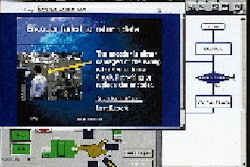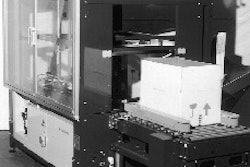Color specialists have long known that each color has a different impact on the human psyche. Forest Brumagen, director of corporate affairs for Pride Container, a corrugated converter in Chicago, conducted research into these color meanings. The results, published recently in Pride's newsletter, are excerpted here. Though green is most recently associated with packaging of healthful foods, it is considered to be the most restful color for the human eye, and people who work in green environments are believed to have fewer stomach ailments. As an example of the psychological effect of green, consider that suicides dropped by a third when London's Blackfriar Bridge was painted green. Blue is equally interesting because for the most part, nature does not generate blue foods. Scientists have conjectured that when our earliest ancestors were foraging for food, blue and black were visual alerts for possibly deadly food. They theorize that this instinctive signal has been passed on through generations. Even now, blue is considered by some to be an appetite supressant. It has been suggested that all-you-can-eat restaurants use blue plates to reduce food consumption, and therefore, costs. The color red is thought to have the opposite effect: it makes food seem more appealing and causes people to eat more and linger longer. Pink can also cause some of these effects. How can package designers take advantage of specific colors? Dr. Morton Walker, author of The Power of Color, writes: "Marketing psychologists advise that a lasting color impression is made within ninety seconds and accounts for sixty percent of the acceptance or rejection of an object, place, individual or circumstance. Because color impressions are both quickly made and long-held, decisions regarding color can be highly important to success." Carlton Wagner, founder of the Wagner Institute for Color Research in Santa Barbara, CA, theorizes that colors can be categorized as either "classifiers" or "declassifiers" in a marketing campaign, which includes packaging. Classifier colors raise the perception or ranking of a particular product and narrow the market for the product. Examples include forest green and burgundy, which are said to appeal to the wealthiest three percent of Americans. They convey a feeling of high quality, as well as price. Conversely, these colors may not be appropriate for mass-market products. Declassifier colors widen the market for a product, because of the popularity of the colors, but can also "cheapen" the product. Examples include orange, yellow and red. Wagner writes that "Orange draws attention, is informal and indicates that a particular product is suitable for everyone. Orange may also be used to make an expensive product appear less expensive." Gray, on the other hand, "tends to move people or products up the socioeconomic ladder."
The color of branding (sidebar)
What colors mean
Sep 30, 1998
Companies in this article
Machinery Basics
New ebook focused on cartoning equipment
Read about the various types of cartoning equipment, how to select the right one, and common pitfalls to avoid. Plus, read equipment advice from CPGs for ultimate cartoning success.
Read More
How AI is reshaping CPG manufacturing operations
Today’s CPG companies are faced with mounting challenges in their manufacturing operations. You have the data that could help you, but can you turn that data into knowledge? See how artificial intelligence can help. Learn what’s working for Pfizer, Post, and Smithfield.
Read More





















